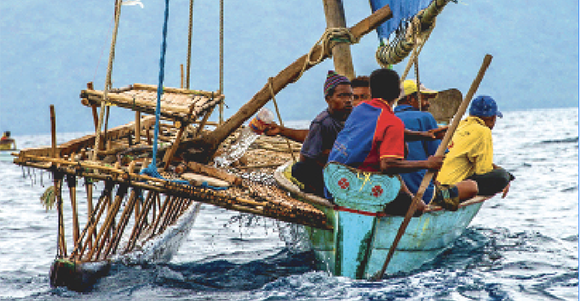Olga Fontanellaz dips her toes into the water at Alotau’s annual Kenu and Kundu Festival.
Striped like a sea snake, black and white Lopo war canoes with sinewy paddlers are fiercely racing to the beat of drums, all competing for the glory of being the best crew. Dressed in the traditional warrior attire, the men are rippling their muscles as they paddle across the bay to shouted encouragements from the crowd.
The long, narrow canoes skim over water to a distant marker and back. Paddled in unison by 20 or more men, the canoes are going at rampant speed.
The sleepy coastal town of Alotau, with its surrounding lush hills and blue ocean, is a meeting place of racers and dancers, who flock from their remote island communities for the Kenu and Kundu Festival, the annual celebration of traditional canoes (kenu) and drums (kundu), which were used in ceremonies and rituals.
The participants, coming from as far as the Trobriand Islands and the Louisiade Archipelago, have to face rough seas and strong winds for days, even weeks, to reach the festival site.
‘The muscled paddlers are heading to the shore, past the cheering crowd applauding their arrival. But the race is not over.’
With more than 600 islands scattered around Milne Bay Province, the canoes are an integral part of Milne Bay culture. They are the main means of transportation for the local communities living on some of the most remote islands in the world. The canoes are used to go to school, work or church, to fish and to transport garden produce.
Early on the morning of the big race, a haunting sound reaches my ears. Gathered on the beach, men and young boys in grass skirts and with proud looks are blowing conch shells and beating drums as a signal to start the race.
The crowd gets bigger, and the excitement becomes more palpable when the canoes appear. Bearing high, elaborately carved and decorated prows, the canoes are the crowd favourites.
Marvelling at the canoes
They are the famous Lopo war canoes of the Huhu people from Maiwara and Wagawaga villages from the Milne Bay mainland. The time they were used in canoe raids has gone and today they are used for the peaceful annual race.
I marvel at the canoes, long and elegant, which go past the giant P&O cruise ship docked near the beach with more than 2000 tourists on board. Suddenly, the canoes appear tiny.
Soon, the muscled paddlers are heading to the shore, past the cheering crowd applauding their arrival. But the race is not over.
‘They were built to enable travel across large distances for the Kula Ring trade, a ceremonial exchange system in the province.’
The tall and slim Gogodala men from Western Province start rowing their long, brightly painted river canoes using paddles with colourful totemic symbols. Measuring up to 20 metres, the canoes are paddled by 50 or even more men. The Gogodala, the occasional special guests of the festival, paddle their imposingly looking canoes from a standing position. Used on the still waters of Western Province, the river canoes are struggling with the waves, and the men barely keep themselves upright.
Once the race is finished, the crowd gathers around Kula trading canoes, large sea-going outriggers from the Trobriand Islands. These bright red outriggers, with a sail woven from pandanus leaves and decorated with elaborately carved splashboards, are ceremonial canoes called waga. They were built to enable travel across large distances for the Kula Ring trade, a ceremonial exchange system in the province.
The exchange of Kula gifts created mutual trust and life-long partnerships between the exchange partners. There is a saying in PNG that ‘once in Kula, always in Kula’.
Air Niugini flies from Port Moresby to Alotau eight times weekly. See airniugini.com.pg.
This is an excerpt of the story Drum roll: a weekend of canoes and drums at Alotau, which was first published in the September-October edition of Paradise, the in-flight magazine of Air Niugini.










Speak Your Mind